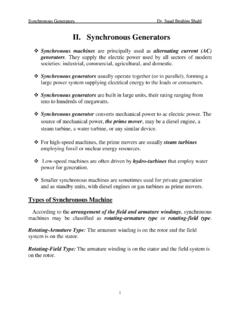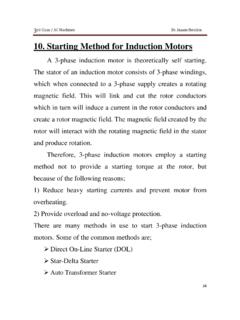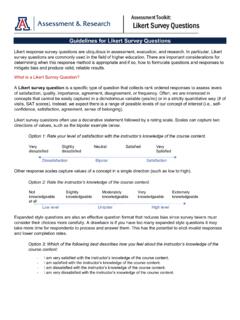Transcription of JUST IN TIME (JIT), LEAN, AND TOYOTA PRODUCTION …
1 JIT, lean , and TPS Dr. Mahmoud Abbas Mahmoud 0 JUST IN TIME (JIT), lean , AND TOYOTA PRODUCTION SYSTEM (TPS) Assistant Professor Dr. Mahmoud Abbas Mahmoud Industrial Engineering Branch Department of PRODUCTION Engineering and Metallurgy University of Technology Baghdad - Iraq 2014 - 2015 JIT, lean , and TPS Dr. Mahmoud Abbas Mahmoud 1 JUST IN TIME (JIT), lean , AND TOYOTA PRODUCTION SYSTEM (TPS) Assist. Prof. Dr. Mahmoud Abbas Mahmoud Industrial Engineering Section Department of PRODUCTION Engineering and Metallurgy University of Technology Baghdad - Iraq 1 History of Manufacturing Management Manufacturing management has a long history goes back to Eli whitney and the concept of interchangeable parts.
2 In 1798, Eli whitney invented a way to manufacture muskets by machine so that the parts were interchangeable. Frederick W. Taylor began to look at individual workers and work methods. The result was Time Study and standardized work. He called his ideas Scientific Management. Taylor was a controversial figure. The concept of applying science to management was sound but Taylor simply ignored the behavioral sciences. In addition, he had a peculiar attitude towards factory workers. Frank Gilbreth added Motion Study and invented Process Charting.
3 Process charts focused attention on all work elements including those non-value added elements which normally occur between the "official" elements. Starting about 1910, Ford and his right-hand-man, Charles E. Sorensen, fashioned the first comprehensive Manufacturing Strategy. They took all the elements of a manufacturing system (people, machines, tooling, and products) and arranged them in a continuous system for manufacturing the Model T automobile. Ford was so incredibly successful he quickly became one of the world's richest men and put the world on wheels.
4 JIT, lean , and TPS Dr. Mahmoud Abbas Mahmoud 2 The Allied victory and the massive quantities of material behind it caught the attention of Japanese industrialists. They studied American PRODUCTION methods with particular attention to Ford practices and the Statistical Quality Control practices of Ishikawa, Edwards Deming, and Joseph Juran. At TOYOTA Motor Company, Taichii Ohno and Shigeo Shingo began to incorporate Ford PRODUCTION and other techniques into an approach called TOYOTA PRODUCTION System or Just In Time. They recognized the central role of inventory.
5 Figure (1) The high points of manufacturing management history. In 1990 James Womack wrote a book called "The Machine That Changed The World". Womack's book was a straightforward account of the history of JIT, lean , and TPS Dr. Mahmoud Abbas Mahmoud 3 automobile manufacturing combined with a comparative study of Japanese, American, and European automotive assembly plants. What was new was a phrase-- " lean Manufacturing." lean Manufacturing caught the imagination of manufacturing people in many countries. lean implementations are now commonplace.
6 The knowledge and experience base is expanding rapidly. 2 Push and Pull systems Push system Is a manufacturing system in which PRODUCTION is based on PRODUCTION plan and where information flows from management to the market, the same direction in which the material flow. Figure (2) Push System Pull system Is a manufacturing system in which PRODUCTION is based on actual demand, and where information flows from market to management in a direction opposite to that in traditional (push) system. Figure (3) Pull System JIT, lean , and TPS Dr. Mahmoud Abbas Mahmoud 4 3 Just in time (JIT) Just-In-Time is a Japanese manufacturing management method developed in 1970s.
7 It was first adopted by TOYOTA manufacturing plants by Taiichi Ohno. The main concern at that time was to meet consumer demands. Because of the success of JIT management, Taiichi Ohno was named the Father of JIT. The just in time manufacturing system considered as a pull system. The principle of Just in time (JIT) is to eliminate sources of manufacturing waste by getting right quantity of raw materials and producing the right quantity of products in the right place at the right time. 4 The Goals of JIT The ultimate goal of JIT is a balanced, smooth and rapid flow of materials through the system.
8 This can be achieved by approaching the following supporting goals first; 1. Zero defects. 2. Zero inventories. 3. Zero set up time. 4. Zero handling. 5. Zero break down. 5 Planning for JIT It is impossible to establish a new JIT system that can be used successfully without modification. Since each manufacturing process is different ( in terms of Goals, Product requirements, Customer requirements etc.), it is up to the individual company to determine the degree of appropriateness and the final application of JIT. However, it is very important to define the plan and objectives before setting up a JIT manufacturing system.
9 JIT, lean , and TPS Dr. Mahmoud Abbas Mahmoud 5 6 Defining the Planning Defining the planning process for a JIT manufacturing system requires an understanding of the objectives of JIT, and the goals and objectives of the JIT system. After the objectives are established for the manufacturing, the process of planning becomes one of determining what is required to meet those objectives. The goal of a JIT approach is to develop a system that allows a manufacturer to have only the materials equipment and people on hand required to do the job.
10 Achieving this goal requires six basic objectives: 1. Integrating and optimizing every step of the manufacturing process. 2. Producing quality product. 3. Reducing manufacturing cost. 4. Producing product on demand. 5. Developing manufacturing flexibility. 6. Keeping commitments and links made between Customers and Suppliers. 7 JIT and Kanaban System The term Kanban has sometimes been used as equivalent to JIT, which certainly is not the truth. Kanban is a Japanese word for card . They often use cards to signal the need for more material, hence the name kanban.














